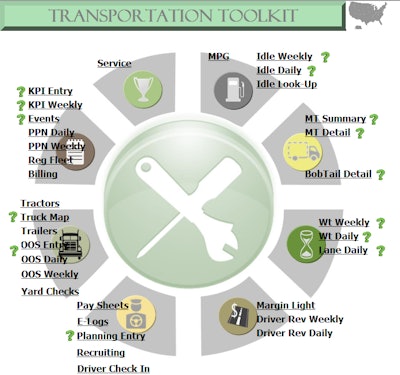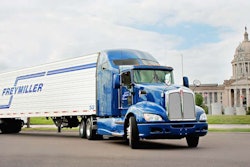CCJ Innovators profiles carriers and fleets that have found innovative ways to overcome trucking’s challenges. If you know a carrier that has displayed innovation, contact CCJ Editor Jeff Crissey at [email protected] or 800-633-5953.
The American Trucking Associations estimates that an additional 89,000 new drivers will need to be brought into the industry each year to keep up with demand and replace the ones who are retiring. ATA expects the current shortage to reach 50,000 this year.
Can motor carriers grow revenues quickly enough to support pay raises to help them recruit and retain drivers? If not, where will they find the money?
 Saddle Creek Logistics Services’ focus on fleet efficiency is paying big dividends
Saddle Creek Logistics Services’ focus on fleet efficiency is paying big dividendsSaddle Creek Logistics Services (CCJ Top 250, No. 232) believes the sky is the limit for driver earnings through its focus on fleet efficiency. A series of projects this year have made it possible for the Lakeland, Fla.-based company to raise driver pay without asking customers for rate increases.
The integrated warehousing, transportation and third-party logistics service provider has more than 500 trucks, 600 drivers and 2,000 trailers domiciled at 14 of its 41 locations nationwide.
Drivers get an increase in their base pay for every year of employment, and there is no cap. Saddle Creek also has implemented a new bonus program that pays out weekly. Drivers earn an additional per-mile rate by exceeding baseline measures for fuel efficiency, safety and accuracy.
There also is no limit on how much drivers can make in bonus money. Michael DelBovo, president of the company’s transportation group, says drivers are averaging an extra 2 cents per mile each week. While some make more and some less, everyone is rewarded for saving the company money.
Pay with no surprises
Pay variations are a common frustration for drivers at any company. To prevent payday surprises, Saddle Creek developed a system for drivers to verify the accuracy of their earnings every day.
The company uses a regional transportation model in which drivers complete round trips every 1.5 trips per day on average. Every time drivers enter and leave a facility, they complete an electronic sign-in process using kiosks set up at every location.
As part of the sign-in process, drivers review their most recent work activities and can dispute information immediately.
“They are paid weekly, but their pay is resolved every day of the week,” DelBovo says. “The check should never be wrong.”
In cases where drivers have a subpar week that results in a low bonus – such as idling their trucks while being detained – the impact is short-lived; all measurements for the bonus program are reset weekly.
Besides giving drivers a continuous feedback loop, the kiosks also help reduce paper. Payroll checks are deposited electronically, but drivers who still prefer pay stubs on paper can print them through the kiosks.
Predictive modeling
On any business day, Saddle Creek has more loads than trucks and drivers in its system, and it also has more divers than trucks. This is by design to maximize efficiency with slip-seat operations.
 Saddle Creek designed a business intelligence dashboard that is customized for everyone in operations to maximize efficiency.
Saddle Creek designed a business intelligence dashboard that is customized for everyone in operations to maximize efficiency.Balancing its dynamic demand and capacity is a constant challenge. Its transportation management system had features to match orders with capacity – but only if that information already had been entered. As the company grew, the need for advanced planning capabilities became greater.
This year, Saddle Creek created an interactive planning dashboard tool with a built-in predictive model that determines when orders and capacity will become available by day of week and time of day. DelBovo describes the tool as an “electronic playbook” for the customer service team.
The dashboard pulls information from the company’s recently developed data warehouse. The predictive model uses historical data on shipping patterns and customer lane commitments to plot days and times that new orders are expected. It also predicts the length of haul.
“This tool enables operations to see freight many days in advance in terms of expected versus planned loads in order to maximize utilization,” says Kristen Lowers, director of transportation systems.
Besides giving advance visibility for shipments, the tool ranks each load by importance based on the lane commitments Saddle Creek has with customers.
The tool also uses predictive modeling to determine where and when capacity will be available, including how many available hours each driver will have.
Business intelligence
Saddle Creek also designed a separate business intelligence dashboard that pulls information from the same data warehouse. The dashboard has been customized for everyone in operations to make them as efficient as possible, Lowers says.
Driver managers and other operations personnel use dual monitors. One screen has the dashboard running at all times to give them instant access to service performance, equipment utilization, fuel efficiency, driver pay, safety, maintenance and more.
 A fuel station tractor map provides a real-time way to track where tractors are parked within the fueling zones and helps direct drivers where to pick up the tractor for their next trip.
A fuel station tractor map provides a real-time way to track where tractors are parked within the fueling zones and helps direct drivers where to pick up the tractor for their next trip.The dashboards eliminate at least 30 minutes of time each day that people used to spend running reports and getting information from different sources, she says.
The dashboard also is accessible on any device. The user interface presents a wheel of icons that represent different steps specific personnel need to complete during the workday. Each icon has various reports, information and tasks associated with that area.
Driver managers and other operations personnel are accountable for reporting to their leaders on what they are doing each day and week to improve the action items on their dashboards.
“There are no rogue processes,” Lowers says. “Everything is unified at the corporate level. Everyone is looking at the same thing.”
Zone fueling
Saddle Creek operates a fleet of compressed natural gas tractors from its terminal locations in Lakeland, Atlanta and Ft. Worth, Texas. To reduce the weight and cost of its trucks, the company chose a smaller tank system.
 Click on the image to see a lineup of the 2015 Innovators
Click on the image to see a lineup of the 2015 Innovators“It’s all about weight,” DelBovo says. “You’ve got to get the maximum payload in there.”
To extend the range of the trucks to 800 miles, their tanks have to be slow-filled, allowed to rest for about an hour and then topped off. This three-stage process delivers a 10 percent greater range by achieving a greater fill percentage.
With limited space in its fueling stations, Saddle Creek needed an efficient way to coordinate the fill process. The company organized its fueling area into 10 zones and, through testing, determined up to 10 trucks could be filled simultaneously in each zone to maximize efficiency.
The next question was how to create an operational procedure so that fueling did not cause unnecessary delays. Saddle Creek worked with its fuel partner, Clean Energy, to redesign its CNG fueling stations as a series of zones in which groups of tractors are filled on a rotating basis in one-hour periods.
A green-yellow-red light system indicates the status of each zone – full, ready to fuel, in process. Drivers use a mobile form to specify the zone where they dropped off their tractor.
“We’ve used our reporting capabilities to engineer a fuel station tractor map,” Lowers says. “This map provides a real-time way to track where tractors are parked within the fueling zones and helps direct drivers where to pick up the tractor for their next trip.”
The fueling system is coordinated by the company’s operations planning system. The programming for the zone fills is based on order volume and demand. The program can change by day and hour.
“Overall, the new innovations have increased operating performance and improved our ability to deliver on our promises to our drivers and to our customers,” Lowers says.











